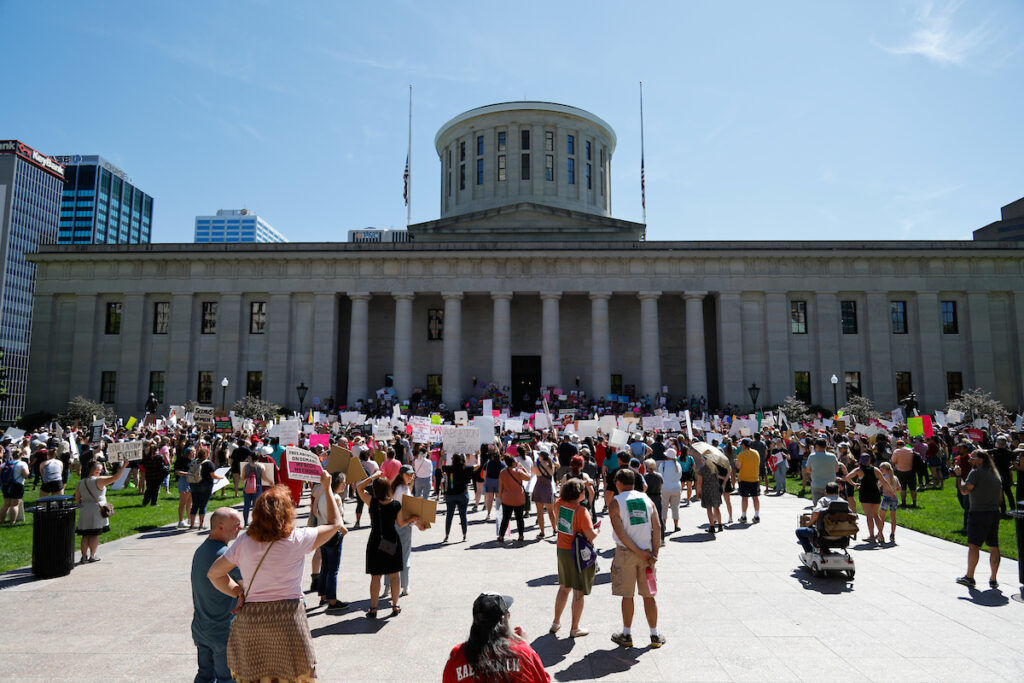Earlier this year, we wrote (here and here) about Ohio’s disastrous proposed amendment to the state constitution, now on the ballot in November as Issue 1. In effect, the ballot initiative would impose on the state a regime of no-limits abortion up to the time of birth and also of life-altering, potentially irreversible, gender-transition procedures, regardless of age, overriding the involvement of parents in the case of minors. Parental rights and basic health and safety protections for women would be eviscerated.
Another danger posed by Issue 1 is that Ohio taxpayers will be forced to fund these procedures. In fact, that is the more likely outcome. Recall the breadth of the proposed amendment’s text, which provides the following regarding the “right to make and carry out one’s own reproductive decisions” covered by the amendment: “The State shall not, directly or indirectly, burden, penalize, prohibit, interfere with, or discriminate against either: 1. An individual’s voluntary exercise of this right or 2. A person or entity that assists an individual exercising this right.” Not only would the state constitution explicitly protect abortion and other procedures involving the human reproductive system, but it also would do so in such absolute terms that even indirectly burdening, interfering with, or discriminating against their provision would be verboten.
What would that mean for state laws barring taxpayer funds from financing abortion on demand? Ohio law currently prohibits state or local funds from being used for abortion except in cases of rape, incest, or to preserve the mother’s life. A good indication of how an adopted Issue 1 would play out comes from past U.S. Supreme Court litigation in which the Hyde amendment’s prohibition of federal funds for most abortions under the Medicaid program was challenged. In 1980, the Court in Harris v. McRae rejected the challenge, but by only one vote in a 5–4 decision. That is a remarkably close margin given the U.S. Constitution’s utter silence on the issue.
In Harris, Justice William Brennan wrote in his dissent that the Hyde amendment’s injection of “financial incentives favoring childbirth into a decision that is constitutionally guaranteed to be free from government intrusion . . . deprives the indigent woman of her freedom to choose abortion over maternity.” The majority, in his view, “fail[ed] to acknowledge that the discriminatory distribution of the benefits of governmental largesse can discourage the exercise of fundamental liberties just as effectively as can an outright denial of those rights through criminal and regulatory sanctions.” Brennan’s dissent was joined by Justices Thurgood Marshall and Harry Blackmun. Justice John Paul Stevens’s dissent maintained in a similar vein that “this discrimination harms not only its direct victims but also the remainder of the class of needy persons that the pool” of money used to fund medical procedures “was designed to benefit.”
There is a strong likelihood that such views, expressed in dissent in a federal case where the Constitution is silent, would become the majority view on the Ohio supreme court if Issue 1 were adopted as part of Ohio’s constitution. After all, the court in that scenario would be confronted with explicit language about indirect interference with and discrimination against those who seek abortion, language that would make it easy for state supreme court justices to reprise themes from the Harris dissents. And the same logic would apply to the denial of public funding for sex-change procedures.
Lest anyone try to dismiss the public-funding issue as a thing of the past, the Left has, in recent years, stepped up its opposition to the Hyde amendment, and Democrats made its repeal a part of the party’s national platform in 2016. When it comes to using the courts to implement this policy — and it is axiomatic for the modern Left that courts are an appropriate vehicle to implement policy preferences — abortion advocates were hoping in 2016 that a Democratic president would be elected and appoint justices who would overturn Harris v. McRae. Of course, that was not to be, and the U.S. Supreme Court overturned Roe v. Wade in Dobbs v. Jackson Women’s Health Organization last year. But that has not stopped abortion advocates from pursuing their objectives on the state level, whether by seeking to have state supreme courts decide their own versions of Roe or by ramming through no-exceptions amendments to state constitutions.
The ACLU, a principal advocate of Issue 1 in Ohio, was co-counsel in the challenge to the Hyde amendment in Harris. After losing that case in the U.S. Supreme Court, the organization’s website boasts that it “pioneered the use of state constitutions to restore state Medicaid funding” and in fact “helped reinstate” such funding. It does not require clairvoyance to discern that the ACLU intends for Issue 1 to be the vehicle to add Ohio to its list of victories — not only by securing an extreme proposal but also by forcing taxpayers to fund much of its tragic consequences.
Source : National Review


